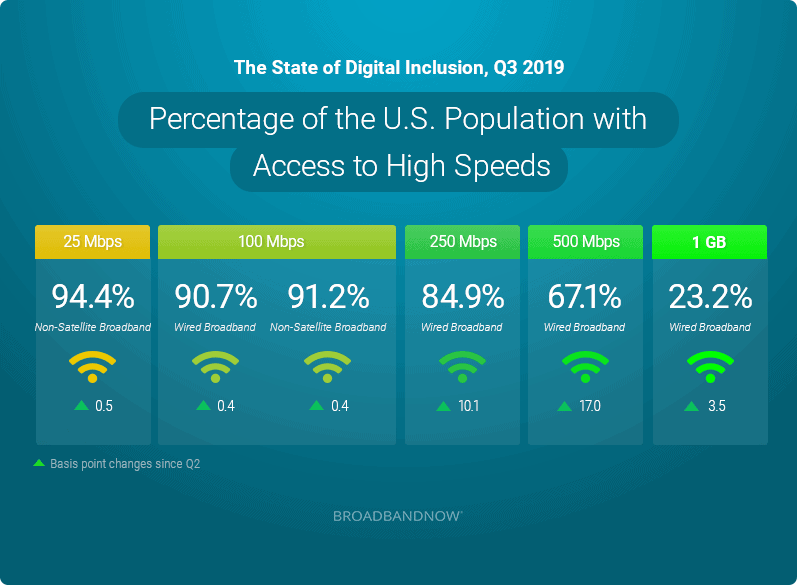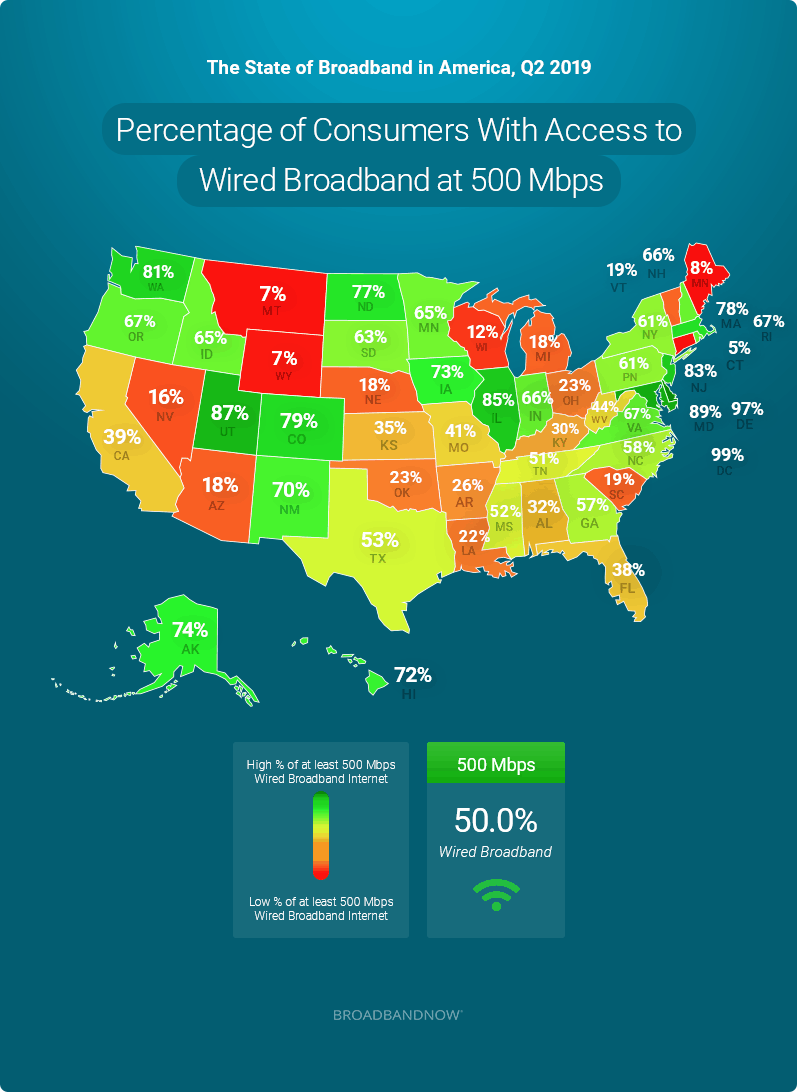America’s digital divide impacts education, opportunity and economic growth. The extent and impact of the digital divide has been so contentious because of the lack of solid datapoints to quantify and classify it. We are introducing a new quarterly broadband report, based on data collected from more than 2,000 ISPs, that focuses on the important issues of affordability and access to ultra-high speeds. Our data shows that less than half of Americans have access to a $60 per month wired broadband internet plan and half of Americans have access to ultra-high speeds at any price, which we are defining in this report as 500 Mbps download speeds or higher.
The State of Digital Inclusion
Percentage of Each State with Access to Affordable Internet

Percentage of the U.S. Population with Access to Low Priced Wired Broadband


Percentage of the U.S. Population with Access to High Speeds

Percentage of Each State with Access to High Speed

New Broadband Bills
Across the country, many new broadband infrastructure bills have been passed, with several focusing squarely on rural deployment strategies. In Alabama, the Broadband Using Electric Easements Accessibility Act will allow electricity providers to use existing or future electric easements for broadband-centric purposes. Elsewhere, proposed bills aim to make it easier for rural ISPs to apply for and receive invaluable federal funding, much of which is typically doled out to the larger incumbent providers.
Low Earth Orbit
The battle for satellite internet dominance has been heating up this year, with both SpaceX and Amazon’s Project Kuiper taking tangible steps toward getting their satellite constellations into orbit and online. Both initiatives have now submitted initial FCC filings, paving the way for additional tests toward the goal of bringing the networks online for consumers starting as early as Q1 2020.
Another competitor, OneWeb, has six test satellites in low orbit currently. SpaceX, for their part, already has just under 60 satellites in place, but Amazon and other entries to the market like The Virgin Group and LeoSat have yet to secure launch dates for their initial tests.
5G Deployment
5G, the new cellular baseband that promises to bring broadband-level speeds to mobile devices, continues to be deployed in waves across the U.S. Major cities like LA and Dallas are seeing small cell transmitters installed across limited sections of their urban centers, but residents on the outskirts (and in crucially underserved rural regions) are being largely left behind.
FCC Spending Caps
In early June, FCC head Ajit Pai proposed a rural broadband spending cap that would disproportionately impact rural and low-income communities. The cap has since received GOP support, with Pai noting that it would serve to “strike the appropriate balance between ensuring adequate funding for the Universal Service programs while minimizing the financial burden on ratepayers and providing predictability for program participants.”
Democratic FCC Commissioner Jessica Rosenworcel called the proposed cap “fundamentally inconsistent with this agency’s high-minded rhetoric about closing the digital divide.”
Percentage of the State Population with Access to Affordable & High-Speed Wired Broadband
| State | Percentage of the Population with Access to $60 Wired Broadband | Percentage of the Population with Access to at least 500 Mbps of Wired Broadband |
|---|
| Alabama | 42.4% | 32.3% |
| Alaska | 0.0% | 73.9% |
| Arizona | 4.2% | 17.7% |
| Arkansas | 35.9% | 25.7% |
| California | 68.1% | 38.8% |
| Colorado | 3.1% | 79.0% |
| Connecticut | 26.5% | 4.8% |
| Delaware | 56.3% | 96.8% |
| District of Columbia | 65.6% | 98.8% |
| Florida | 58.0% | 37.9% |
| Georgia | 55.0% | 57.0% |
| Hawaii | 50.6% | 72.2% |
| Idaho | 64.5% | 65.5% |
| Illinois | 59.4% | 84.6% |
| Indiana | 48.5% | 66.2% |
| Iowa | 15.9% | 73.4% |
| Kansas | 48.3% | 34.5% |
| Kentucky | 36.6% | 30.3% |
| Louisiana | 42.2% | 21.9% |
| Maine | 0.4% | 7.7% |
| Maryland | 61.2% | 89.0% |
| Massachusetts | 42.3% | 77.8% |
| Michigan | 54.6% | 18.5% |
| Minnesota | 15.5% | 64.9% |
| Mississippi | 46.0% | 52.2% |
| Missouri | 49.1% | 41.2% |
| Montana | 0.5% | 6.6% |
| Nebraska | 9.9% | 18.4% |
| Nevada | 12.2% | 15.5% |
| New Hampshire | 1.6% | 66.2% |
| New Jersey | 76.0% | 82.6% |
| New Mexico | 11.7% | 70.1% |
| New-York | 69.0% | 61.3% |
| North Carolina | 39.2% | 58.0% |
| North Dakota | 76.5% | 76.7% |
| Ohio | 46.3% | 22.8% |
| Oklahoma | 37.0% | 22.8% |
| Oregon | 23.4% | 66.8% |
| Pennsylvania | 42.5% | 60.9% |
| Rhode Island | 89.5% | 66.8% |
| South Carolina | 50.4% | 18.7% |
| South Dakota | 69.8% | 62.6% |
| Tennessee | 58.4% | 51.1% |
| Texas | 57.7% | 53.1% |
| Utah | 22.9% | 86.5% |
| Vermont | 0.8% | 18.7% |
| Virginia | 47.0% | 66.9% |
| Washington | 15.4% | 80.5% |
| West Virginia | 4.5% | 43.8% |
| Wisconsin | 41.7% | 11.5% |
| Wyoming | 13.3% | 6.7% |
About BroadbandNow Data
Data for the BroadbandNow Pricing Study comes from publicly available plan data from more than 2,000 internet service providers from Q2 of 2019. We defined broadband internet as a residential provider plan with at least 25Mbps download and 3Mbps upload speeds, wired broadband as cable, fiber, and DSL technologies, and non-satellite broadband as cable, fiber, DSL, and fixed wireless technologies. Coverage was based on what providers have reported on their most recent FCC Form 477 at the census block level. If a provider has indicated that they have coverage in a census block, we assume that all of the provider’s national plans are also available in that given block. Plan pricing is based on the regular monthly rate offered. Promotional rates are only considered if that is the only advertised price publicly available.

